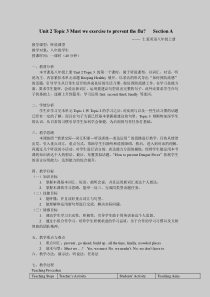 DOC
DOC
【文档说明】《Unit 2 Topic 3 Must we exercise to prevent the flu》教案设计3-八年级上册英语仁爱(科普版).doc,共(5)页,40.000 KB,由小喜鸽上传
转载请保留链接:https://www.ichengzhen.cn/view-104958.html
以下为本文档部分文字说明:
Unit2Topic3Mustweexercisetopreventtheflu?SectionA-------仁爱英语八年级上册教学课型:听说课型教学对象:八年级学生授课时间:一课时(40分钟)一、教材分析本节课是八
年级上册Unit2Topic3的第一个课时,属于听说课型,以词汇,对话,听说为主。内容紧扣本单元话题KeepingHealthy展开,以采访的形式导出“如何预防流感”的话题,引导学生从日常生活开始养成良好的生活习惯,做好预防流感工作。在学习技能方面,要求学生能听,会说出新词汇,运用提建议句型
说出完整的句子,此外还要求学生在句子的基础上,逐渐上升到篇章,学习运用first,second,third,finally等连词。二、学情分析学生在学习完本单元Topic1和Topic2的学习之后,对疾病与以及一些生活习惯的话题已
经有一定的了解,而且在句子方面已经基本掌握提建议的句型。Topic3则顺势加深学生的认识,从日常的习惯引导学生如何学会保健,为后面的写作任务打基础。三、教学思路本课按照“情景交际---词汇积累---听说训练---表达运用”的思路进行教学。目的从情景出发,引入重点词汇,重点句式,帮助学生扫除
听和说的障碍。然后,进入到对话的理解。再通过几个听说的小活动,对学生进行语言的,表达能力方面的操练,使得学生能运用本节课的知识表达个人的想法。最后,布置类似话题,“HowtopreventDengueFever”拓展学生的语言应用能力,达到能力的综合提升。四、教学目标(一)知识目标1.掌
握本课基本词汇,短语,能听会说,并且运用新词汇表达个人想法。2.掌握本课的学习思路,能举一反三,完成同类型话题任务。(二)技能目标1.能听懂,并且读好重点词汇与句型。2.能理解和运用新句型进行交流,解决实际问题。(三)情感目标1.调动学生学习主动性,积极性,引导学生敢
于用英语表达个人思想。2.通过小组合作学习,培养学生积极求进的学习品质,乐于合作的学习习惯以及互相帮助的团队精神。五、教学重点与难点1.重点词汇:prevent,goahead,buildup,allthetime,finally,crowdedplaces2.基本句型:Mu
stwe…?Yes,wemust.No,weneedn’t.No,wedon’thaveto.六、教学方法:演示法,听说法,任务法七、教学过程TeachingProcedureTeachingStepsTeacher’sActivityStudents’Activi
tyTeachingAimsStep1Lead-in1.Warmup.ShowSsavideoandask:What’swrongwiththeboy?Canyougivehimsomesuggestions?2.LeadSstothink:Whatshouldwed
otopreventtheflu?3.Showsomepicturesandaskinpatterns:Mustwe…?LeadSstoanswer:Yes,wemust.No,wemustn’t.No,wedon’thaveto.1.Watchthevideo
andanswerthequestions.2.Brainstormandgivesuggestions.3.Answerandimitate.Thentrytomakesimilardialogues.1.WarmupandfocusS
s’attention.2.EncourageSstospeakinEnglishandreviewthephraseslearnedbyusingshould,must,hadbetter.3.Presentthekeysentencepatternsandlea
dSstomaster.Step2PresentationandPractice1.ShowthepictureofthedialogueandaskSstoguessthecharactersofthem.2.Playthedialoguef
orthefirsttime.Ask:Whatisthedialogueabout?HowmanysuggestionsdoesDr.Ligive?3.Ask:Howdoyouknowthereare4suggestions?Andwritedownthek
eywords.4.PlaythedialogueforthesecondtimeandaskSstocheckoutthesuggestions.5.Playthedialogueforthethirdtimeandrepeat
.AndaskSstoreadthedialogueingroups.6.ShowthephrasesinChineseandaskSstofindthemoutandunderline.Thenfinishthesentences.7.AskSstoas
kandanswerquestionsofunderstandingingroups.1.Guessthecharacters.Getreadyforlistening.2.Listenandtrytofindouttheanswers
.3.Gettheconjunctions.4.Listenagainandcheckoutthesuggestionsmentioned.5.Listenandrepeat.Imitatethepronunciationandintonation.6.Gettoknow
themeaningsandusageofthekeyphrases.7.Getfurtherunderstandingofthedialogue.1.FocusSs’attention.2.Practicelisteningandunderstandingskills.3.Lea
rntousethewordstoputthingsinorder.4.Learnbypracticing.5.Practicespeakingskillbyrepeatingandimitating.6.Gettheusageofthekeyphrases.
7.GothroughthedialogueandencourageSstothinkandsolveproblemsbythemselves.Step31.AskSstofinishexercise2&3on1.Practicelistening1.Getmoreexerciseand
Consolidationbooks.Thenchecktheanswers.2.Readthekeyphrasestogether.skillandpracticeusingthephrasescorrectly.2.RemindSsofth
ekeyphrases.makefullunderstandingofthekeyphrases.Step4Task1.GuideSstotalkabouthowtopreventDengueFever?2.LeadSstodiscussi
ngroupson“HowtopreventDengueFever?”Thenwriteanoutline.3.ShowsomeproductionsofSs.1.Learntothinkandtrytotalkwiththeirownwords.2.
Discussingroupsandwriteanoutlineeachgroup.3.Learnfromeachother.1.EncourageSstothinkmoreandspeakmorebydiscussingthetopic.2.GiveSsmorechances
tolearnteamworkandspeakEnglishbyusingkeyphrases.3.GuideSstolearnfromeach.Step5SummaryMakeaconclusionandcallonSstok
eepgoodhabitstopreventtheflu.Remindthekeywordsandphrasesandlearntokeepgoodhabits.CallonSstolearntokeepgoodh
abitstopreventtheflu.Step6Homework1.Writeapassageon“HowtopreventDengueFever”.2.FinishP44(3)onthebook.Finishthehomeworkindivi
duallyafterclass.Consolidatebydoinghomework.Blackboard八、堂上练习Unit2Topic2Mustweexercisetopreventtheflu?SectionA1.重
点单词:question,prevent,finally,journalist,2.重点词组:asksomequestions,goahead,build…up,keeptheairfresh,changeclothes,crowdedplaces,needn’t,don’thaveto.3.重点
语法:Mustwe….?Yes,wemust.No,wedon’thaveto.I完成句子1.我必需先完成作业吗?不,不必._______________________________________________first?NO,you___
__________________.2.你必需多做运动来增强体质.Youmustdomoreexerciseto______________________________________________.Unit2Topic2Mustweexerc
isetopreventtheflu?SectionApreventMustwe…?First,…buildupYes,wemust.Second,…keepawayfrom..No,wedon’thaveto
.Third,…goaheadNo,weneedn’t.Finally,…crowdedplaces3.去人群密集的地方是很危险的.Itisdangerousto_______________________________________________________.4.我们应该打开窗户保持
空气清新.Weshouldopenthewindowto_______________________________________________________.5.一日一苹果,医生远离我.Anappleaday______________________________________
___________________________.IIWorkingroupsandwriteanoutline.HowtopreventDengueFever?登革热First,_______________________________
_________________________________________________________________________________________________________Second,__________
____________________________________________________________________________________________________________
__________________Third,________________________________________________________________________________________________________
___________________________________Finally,_______________________________________________________________________________
___________________________________________________________九、课后反思按照教学计划里的思路“情景交际---词汇积累---听说训练---表达应用”,本节课在40分钟内基本能完成预设的
教学任务。而教学目标也收到初步成效。基于本课为听说课,学生的听和说,必然是首要的学习任务。而在本课教学设计中,教师也对听和说有所侧重。但是反观这节课,有值得再次考虑的几个方面。第一,在拓展话题,迁移能力时,老师直接从复述本文
主题“Howtopreventtheflu”中间也没有过度,就让学生进行思考“HowtopreventDengueFever”,讨论产出。对于一些能力较好的学生来说这不成问题。但是对于学习接受能力较弱的学生来说,这个活动未必能收到预期效果。因此,在引入第二
个类似话题的时候,老师可以对登革热进行简单提问,降低难度,引起学生的注意和兴趣。比如老师可以提出以下问题“Doyoulikemosquitoes?”“Whydon’tyoulikethem?”“Whatwilltheycause
?““HowcanwepreventDengueFever?“等。通过这样简单易懂的问答,学生首先对这个新的话题降低了压力,同时因为老师的一些引导,学生逐渐领悟到此话题与我们刚学的话题原来有类似的地方,可以用本堂课所学的知识来解决问题,那么他们对自己就感到更自信,也更加喜欢
开口说英语。这就可以更顺利地促成学生知识能力的迁移。第二,在课堂最后分小组讨论和发表“HowtopreventDengueFever”这一活动时,教师让学生分小组讨论,然后口头阐述个人的建议做法。原设计任务完成。其实,这项任务设定的初衷,
是为了后面的阅读和写作教学做铺垫。因此,在原来的设计上,老师可以做出适当的调整,让学生讨论之后,把小组讨论的成果写在白纸上。然后请一名组员上台一边展示小组成果,一边诵读其内容。最后,老师可以选择当中较好的一篇作为例子,提出思考性问题,比如。“这像
不像一篇作文”,“为什么像”,“为什么不像”,“如何才能使它成为一篇像样的文章”,“你能不能给一些合理建议”等问题。一步一步,引导学生从词汇到句子,最后到文章的产出,那么这样的话,本节课的效能将会得到进一步的提高。以上,便是本人对本节课的一些反思。
课堂,每天在进行,时代,不断在进步。课堂的教学也应因应需要,因应变化,不断进行深刻反思。
 辽公网安备 21102102000191号
辽公网安备 21102102000191号
 营业执照
营业执照